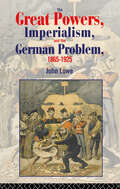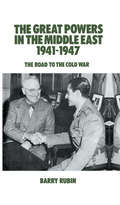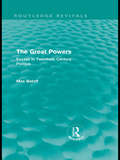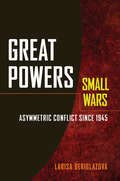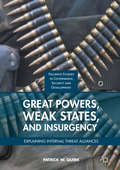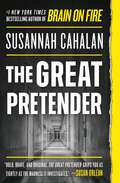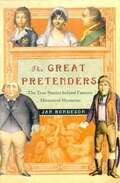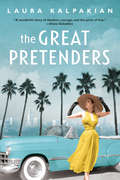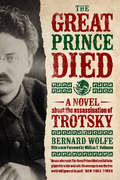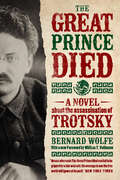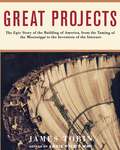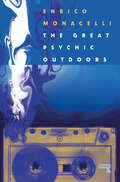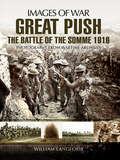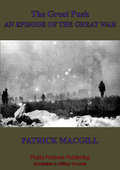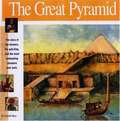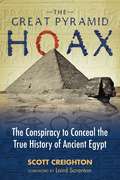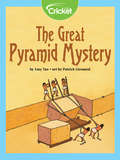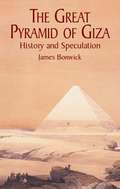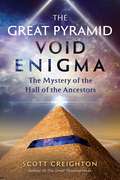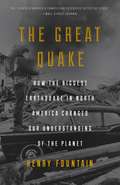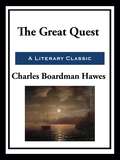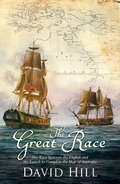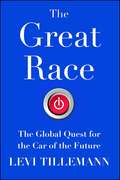- Table View
- List View
The Great Powers, Imperialism and the German Problem 1865-1925
by John LoweThis is a lucid and well-structured text dealing with key issues in international affairs from the period of German unification to the aftermath of World War I. It: * Provides excellent explanation and analysis of the central issues * Clarifies a notoriously complex period of international history * Updates traditional books in this field of 19th and 20th century diplomatic/international history * Takes a thematic approach * Leads students through the main events and reviews recent trends in historical debate and scholarship * Includes an annotated bibliography Consideration of `the German problem' and `the Balkan problem' have taken on a new urgency and relevance with recent developments in Europe, and this book provides an excellent introduction to the subject.
The Great Powers in the Middle East 1941-1947: The Road to the Cold War
by Barry RubinFirst Published in 1981. Routledge is an imprint of Taylor & Francis, an informa company.
The Great Powers: Essays in Twentieth Century Politics (Routledge Revivals)
by Max BeloffThis re-issued work, first published in 1959, is a collection of essays by British historian Max Beloff, designed to help us to understand and interpret the political problems of the twentieth century. The essays are divided into three key areas: the challenges and limitations of interpretation from a historian's perspective, the appropriate scale for political activity and organisation in the modern world, and the emergence of the United States of America as the most powerful nation on the planet.
Great Powers, Small Wars: Asymmetric Conflict since 1945
by Larisa DeriglazovaA sophisticated appraisal of the problem of asymmetric conflict in the post–World War II period.In a sophisticated combination of quantitative research and two in-depth case studies, Larisa Deriglazova surveys armed conflicts post World War II in which one power is much stronger than the other. She then focuses on the experiences of British decolonization after World War II and the United States in the 2003 Iraq war. Great Powers, Small Wars employs several large databases to identify basic characteristics and variables of wars between enemies of disproportionate power. Case studies examine the economics, domestic politics, and international factors that ultimately shaped military events more than military capacity and strategy.
Great Powers, Weak States, and Insurgency
by Patrick W. QuirkThis book offers an original and theoretically rich examination into the dynamics of alliances that great powers and weak states form to defeat threats, such as rebellion or insurgency, within the smaller state's borders. The author examines contemporary examples of such "internal threat alliances," including Russia's collaboration with Syria's Assad regime to defeat anti-government rebels and U. S. cooperation with Afghanistan's ruling political elite to combat the Taliban. In each case, the weaker state's leadership wanted to remain in power while the great power sought to safeguard its interests linked to the regime's stability. The book adds to International Relations (IR) theory by presenting a distinct conceptual framework that explains why internal threat alliances form, why some are more cohesive than others, and why some are effective while others are not. It thus promises to be of interest to IR scholars and students working in the areas of security studies, alliance dynamics, political violence, and civil war, but also to policy-makers grappling with how to salvage interests, such as access to natural resources or regional stability, imperiled by violence in weak states.
The Great Pretender: The Undercover Mission That Changed Our Understanding of Madness
by Susannah Cahalan"One of America's most courageous young journalists" and the author of the #1 New York Times bestselling memoir Brain on Fire investigates the untold history of the shocking experiment that revolutionized modern medicine (NPR). <P><P>For centuries, doctors have struggled to define mental illness--how do you diagnose it, how do you treat it, how do you even know what it is? In search of an answer, in the 1970s a Stanford psychologist named David Rosenhan and seven other people--sane, normal, well-adjusted members of society--went undercover into asylums around America to test the legitimacy of psychiatry's labels. <P><P>Forced to remain inside until they'd "proven" themselves sane, all eight emerged with alarming diagnoses and even more troubling stories of their treatment. Rosenhan's watershed study broke open the field of psychiatry, closing down institutions and changing mental health diagnosis forever. <P><P>But, as Cahalan's explosive new research shows, very little in this saga is exactly as it seems. What really happened behind those closed asylum doors, and what does it mean for our understanding of mental illness today?
The Great Pretenders: True Stories Behind Famous Historical Mysteries
by Jan BondesonJAN BONDESON, M.D. focuses his medical expertise and his inciteful wit on the great unsolved mysteries of disputed identity of the last two hundred years. Did the son of Louis Xvi and Marie Antoinette die during his imprisonment in the Temple Tower, or was he one of the people claiming to be the Lost Dauphin after the Terror ended? What does DNA testing on the heart proported to belong to the Dauphin reveal? Was Kaspar Hauser, the mysterious boy who claimed to have spent his entire childhood in a subterranean dungeon, really the Crown Prince of Baden, or was he suffering from pseudologia fantastica, a pathological desire to deceive other people? And when an eccentric and reclusive duke built a complete set of tunnels and rooms beneath his country estate, who is to say that he also didn't have a second life as a shopkeeper with a separate family in London? In this highly anticipated work covering the most famous unsolved cases of disputed identity, Jan Bondeson uncovers all the evidence, then applies his medical knowledge and logical thinking to ascertain the true stories behind these fascinating histories. JAN bondeson, M.D., professor at University of Wales College of Medicine, Cardiff, is the author of Buried Alive, A Cabinet of Medical Curiosities, The Feejee Mermaid, The Two-Headed Boy, and The London Monster, among other works.
The Great Pretenders
by Laura KalpakianThe daughter of Hollywood royalty, Roxanne Granville is used to getting what she wants—even if she has to break the rules. But after a falling-out with her grandfather, a powerful movie mogul, she has to face life on her own for the first time.…Roxanne forges a career unique for women in the 1950s, becoming an agent for hungry young screenwriters. She struggles to be taken seriously by the men who rule Hollywood and who often assume that sexual favors are just a part of doing business. When she sells a script by a blacklisted writer under the name of a willing front man, more exiled writers seek her help. Roxanne wades into a world murky with duplicity and deception, and she can’t afford any more risks.Then she meets Terrence Dexter, a compelling African American journalist unlike anyone she’s ever known. Roxanne again breaks the rules, and is quickly swept up in a passionate relationship with very real dangers that could destroy everything she’s carefully built.Roxanne Granville is a woman who bravely defies convention. She won’t let men make all the rules, and won’t let skin color determine whom she can love. The Great Pretenders is a riveting, emotional novel that resonates in today’s world, and reminds us that some things are worth fighting for.
Great Pretenders
by Karen SchoemerFebruary 1964: The Beatles step onto the tarmac at JFK International Airport and turn the country on its head. It's the advent of rock and roll's uninterrupted reign, youthful rebellion, and overt teenage sex. It's also the deathblow for the pop music of another generation -- the songs of Pat Boone and Georgia Gibbs -- and all its perky, white-bread conformity. Not two years later, Karen Schoemer is born, and comes of age with rock and roll. While her parents might enjoy the new music, the cultural upheaval passes them by, and they cling to the promises made by the music they loved as teenagers, the sweet, innocent 1950s pop of Patti Page, Frankie Laine, and the like. But having courted and wed against a backdrop of ideals peddled by this music -- finding true love, living happily ever after -- Schoemer's parents, like so many people, are crushed by disappointment when love doesn't deliver what the songs promised. Fifties pop falls quickly off the charts; their marriage eventually falls apart. In Great Pretenders, a lively, provocative blend of memoir and music criticism, former Newsweek pop music critic Karen Schoemer tries to figure out what went so wrong, way back in the hazy past, for her parents' marriage and for the music of their youth. To find the answers, she embarks on a strange, lonely journey in search of some of the brightest stars of the 1950s. Schoemer's search started when, twenty years after her parents' divorce, the new Connie Francis box set appeared on her desk at Newsweek. Now a successful rock critic dispensing post-punk opinions to the hipoisie, she was about to toss aside this relic when she was struck by the cover image of Francis, which bore an uncanny resemblance to her own mother; on a whim, she played one of the CDs. For all their cloying, simplistic sentimentality, songs like "Where the Boys Are" had an undeniable power -- "the sound of every teenage girl in every bedroom on every lonely Saturday going back a thousand years." It was the music of her parents' long-lost adolescence, and much to her surprise, it moved her. Thus Schoemer, arbiter of Gen X cool, found herself falling into the saccharine thrall of 1950s pop music, that pariah of the rock establishment. Even as her colleagues tried to steer her away from the terminally uncool genre, she tracked down seven former pop idols of the late 1950s and early 1960s: Connie Francis, Fabian, Pat Boone, Patti Page, Tommy Sands, Georgia Gibbs, and Frankie Laine. As she became privy to their inner lives and immersed herself in their music, Schoemer revised her own notions about the fifties at the same time that she explored her family's vexed dynamic. The result is a wonderful romp through an unappreciated chapter in music history and, more important, through her own past. Full of humor, insight, and unflinching honesty, Great Pretenders bucks the received wisdom, explores the intersections of our private lives and pop culture, and broadens our understanding of a crucial moment in our history.
The Great Prince Died: A Novel about the Assassination of Trotsky
by Bernard WolfeOn August 20, 1940, Marxist philosopher, politician, and revolutionary Leon Trotsky was attacked with an ice axe in his home in Coyoacán, Mexico. He died the next day. In The Great Prince Died, Bernard Wolfe offers his lyrical, fictionalized account of Trotsky’s assassination as witnessed through the eyes of an array of characters: the young American student helping to translate the exiled Trotsky’s work (and to guard him), the Mexican police chief, a Rumanian revolutionary, the assassin and his handlers, a poor Mexican "peón,” and Trotsky himself. Drawing on his own experiences working as the exiled Trotsky’s secretary and bodyguard and mixing in digressions on Mexican culture, Stalinist tactics, and Bolshevik history, Wolfe interweaves fantasy and fact, delusion and journalistic reporting to create one of the great political novels of the past century.
The Great Prince Died: A Novel About the Assassination of Trotsky
by Bernard WolfeOn August 20, 1940, Marxist philosopher, politician, and revolutionary Leon Trotsky was attacked with an ice axe in his home in Coyoacán, Mexico. He died the next day. In The Great Prince Died, Bernard Wolfe offers his lyrical, fictionalized account of Trotsky’s assassination as witnessed through the eyes of an array of characters: the young American student helping to translate the exiled Trotsky’s work (and to guard him), the Mexican police chief, a Rumanian revolutionary, the assassin and his handlers, a poor Mexican “peón,” and Trotsky himself. Drawing on his own experiences working as the exiled Trotsky’s secretary and bodyguard and mixing in digressions on Mexican culture, Stalinist tactics, and Bolshevik history, Wolfe interweaves fantasy and fact, delusion and journalistic reporting to create one of the great political novels of the past century.
Great Projects: The Epic Story of the Building of America, from the Taming of the Mississippi to the Invention of the Internet
by James TobinSince the earliest days of the republic, great engineering projects have shaped American landscapes and expressed American dreams. The ambition to build lies as close to the nation's heart as the belief in liberty. We live in a built civilization, connected one to another in an enormous web of technology. Yet we have all too often overlooked the role of engineers and builders in American history. With glorious photographs and epic narrative sweep, Great Projects at last gives their story the prominence it deserves.Each of the eight projects featured in this masterful narrative was a milestone in its own right: the flood-control works of the lower Mississippi, Hoover Dam, Edison's lighting system, the spread of electricity across the nation, the great Croton Aqueduct, the bridges of New York City, Boston's revamped street system, known as the Big Dig, and the ever-evolving communica- tions network called the Internet. Each project arose from a heroic vision. Each encountered obstacles. Each reveals a tale of genius and perseverance.James Tobin, winner of a National Book Critics Circle Award, explains the four essential tasks of the engineer: to protect people from the destructive force of water while harnessing it for the enormous good it can do; to provide people with electricity, the motive force of modern life; to make great cities habitable and vital; and to create the pathways that connect place to place and person to person. Tobin focuses on the indi- viduals behind our greatest structures of earth and concrete and steel: James Buchanan Eads, who walked on the floor of the Mississippi to learn the river's secrets; Arthur Powell Davis and Frank Crowe, who imagined a dam that could transform the West; Thomas Edison, who envisioned a new way to light the world; Samuel Insull, the organizational mastermind of the electrical revolution; the long-forgotten John Bloomfield Jervis, who assured New York's future with the gift of clean water; Othmar Ammann, the modest Swiss-American who fought his mentor to become the first engineer to bridge the lower Hudson River; Fred Salvucci, the antihighway rebel who transformed the face of Boston; and J.C.R. Licklider, the obscure scientist who first imagined the Internet. Here, too, are the workers who scorned hardship to turn the engineers' dreams into reality, deep underground and high in the sky, through cold and heat and danger. In Great Projects -- soon to be a major PBS television series by the Emmy Award-winning Great Projects Film Company -- we share their dreams and witness their struggles; we watch them create the modern world we walk through each day -- the "city upon a hill" that became our America.
The Great Psychic Outdoors: Adventures in Low Fidelity
by Enrico MonacelliExplores the weird world of lo-fi music to investigate its revolutionary potential and its ability to subvert what we think music can do.Homemade records, tape-hiss worship and a taste for a very peculiar kind of psychedelia have carved themselves a weird niche in the contemporary musical landscape under the name of lo-fi.This genreless genre, characterized by poor recordings and rough sounds, spanning from the most extreme heavy metal to the sweetest ear-candies pop can offer, has become a solid presence in our collective sensibility. And yet, it has largely been neglected: this staunch refusal of anything hi-fi and hi-tech has fallen under the radar of the categories we use to analyse ourselves and our times.The Great Psychic Outdoors, dedicated to the most interesting and controversial artists in this movement, will rectify this injustice and vindicate the revolutionary potential of lo-fi music, engaging with this weird genre on its own terms and facing head on the contradictions and possibilities of this multi-faceted phenomenon. Confronting the aesthetic and conceptual stakes of this sonic craft, The Great Psychic Outdoors shows what lo-fi says about us, our lives under capitalism and the strange ways we cope with pain, madness and beauty.
Great Push: The Battle of the Somme, 1916 (Images of War)
by William LangfordIn 1916, Sir Douglas Haig, commanding the BEF, began his great offensive to drive the invaders off the ground they had been occupying for over a year and a half. The Great Push, as the offensive was advertised to the nation, began 1 July 1916. A glossy picture magazine was produced to inform the British public of the progress of the offensive. Over a four month period until the Battle of the Somme faded away in November the magazine appeared with the following advertising blurb:Sir Douglas Haigs Great Push; The Battle of the Somme; A popular, pictorial and authoritative work on one of the Greatest Battles in History, illustrated by about 700 wonderful Official Photographs and Cinematograph Films; By Arrangement With the War Office; beautifully printed on the Best English Art Paper. As is well known, the Great Push turned out to be little more than a nudge, but, for the sake of national morale, the British public had to be encouraged to believe that all was going well; especially in view of the horrific casualties wrecking the lives of families throughout the land.The Great Push, in the form of Images of War, helps capture the propaganda thrust of the times and presents once more the illustrations of those bewildering days.
The Great Push - An Episode Of The Great War
by Patrick MacgillWinner of a much esteemed star from doyen of First World War writers Cyril Falls, the author writes of the battle of Loos in 1915, particularly graphically. MacGill was actually engaged and wounded during the battle whilst serving with the London Irish Rifles."MacGill, who had won considerable fame as a writer of "navvy " romances before the War, wrote one of the most vivid English accounts of a battle that was published while it was still in progress. He used to be known as a "powerful," meaning a rather brutal writer, but a study of The Great Push beside some of the contemporary novels and narratives will show what an admirable advance in "power" has been made since then. His account covers quite a short period: the Battle of Loos with its preparatory period and its aftermath. He himself was a stretcher-bearer. He saw the famous football dribbled over by his regiment, the London Irish, and saw it afterwards deflated on the German wire. The passages describing a night in Loos and the subsequent panic are very fine." p. 215 Cyril Falls. War Books, London, 1930.
The Great Pyramid
by Elizabeth MannHere's the story of the Great Pyramid and the people who built it. In the author's telling, the Old Kingdom comes alive: a nation of farmers living on the green edge of a harsh desert with a king who was a god in life and in death. Tens of thousands of farmers left home each year to chisel hard stone without iron tools and move 10-ton blocks up steep grades without the use of a wheel, all to the glory of the Pharaoh.
The Great Pyramid Hoax: The Conspiracy to Conceal the True History of Ancient Egypt
by Laird Scranton Scott CreightonReveals how the only hard evidence that dates the Great Pyramid--the quarry marks discovered by Colonel Vyse in 1837--was forged • Includes evidence from the time of the discovery of the marks: Vyse’s private field notes, surveys, facsimile drawings, and eye-witness testimony • Explains why Vyse was driven to perpetrate a fraud inside the Great Pyramid • Examines recent chemical analysis of the marks and high-definition photos to reveal errors and other anomalies within the forged Khufu cartouche Despite millennia of fame, the origins of the Great Pyramid of Giza are shrouded in mystery. Believed to be the tomb of an Egyptian king, even though no remains have ever been found, its construction date of roughly 2550 BCE is tied to only one piece of evidence: the crudely painted marks within the pyramid’s hidden chambers that refer to the 4th Dynasty king Khufu, discovered in 1837 by Colonel Howard Vyse and his team. Using evidence from the time of the discovery of these “quarry marks”--including surveys, facsimile drawings and Vyse’s private field notes--along with high definition photos of the actual marks, Scott Creighton reveals how and why the marks were faked. He investigates the anomalous and contradictory orthography of the quarry marks through more than 75 photos and illustrations, showing how they radically depart from the established canon of quarry marks from this period. He explains how the orientation of the Khufu cartouche contradicts ancient Egyptian writing convention and how one of the signs is from a later period. Analyzing Vyse’s private diary, he reveals Vyse’s forgery instructions to his two assistants, Raven and Hill, and what the anachronistic sign should have been. He examines recent chemical analysis of the marks along with the eye-witness testimony of Humphries Brewer, who worked with Vyse at Giza in 1837 and saw forgery take place. Exploring Vyse’s background, including his electoral fraud to become a member of the British Parliament, he explains why he was driven to perpetrate a fraud inside the Great Pyramid. Proving Zecharia Sitchin’s claim that the quarry marks are forgeries and removing the only physical evidence that dates the Great Pyramid’s construction to the reign of Khufu, Creighton’s study strikes down one of the most fundamental assertions of orthodox Egyptologists and reopens long-standing questions about the Great Pyramid’s true age, who really built it, and why.
The Great Pyramid Mystery
by Amy TaoNo one knows for sure just how the ancient Egyptians built the Great Pyramid of Giza, which is taller than the Statue of Liberty. How could an ancient civilization have achieved this engineering feat? Perhaps the solution to this mystery can be answered with simple machines!
The Great Pyramid of Giza: History and Speculation (Egypt Ser.)
by James BonwickClassic exploration of the Great Pyramid's construction and objectives combines imagination, erudition. Physical form; when it was built, and by whom; roles as an astronomical observatory, source of inspiration for religious teachings, scientific and mystic implications. Unabridged republication of the classic 1877 edition.
The Great Pyramid Void Enigma: The Mystery of the Hall of the Ancestors
by Scott Creighton• Analyzes ancient Coptic-Egyptian texts and evidence from astronomy and archaeology to show how the Big Void may be a grand &“Hall of Ancestors&” • Explores the controversy surrounding the discovery of the Big Void and debunks many of the theories regarding the purpose of this massive new &“chamber&” • Reveals how the Great Pyramid was built by Khufu as an indestructible &“recovery vault&” to help Egyptian civilization rebuild after an anticipated cataclysm In November 2017, an international team of more than 30 scientists published the results of their two-year-long Great Pyramid research project in the journal Nature. Using an advanced imaging technique known as muon radiography, three groups working independently from each other discovered a massive, previously unknown space within the Great Pyramid of Giza. Mainstream Egyptologists suggest that the &“Big Void&” is simply a stress-relieving device for the Grand Gallery. But, as Scott Creighton reveals, ancient Coptic-Egyptian texts describe exactly what the Big Void is. Exploring the controversy surrounding the Big Void, Creighton artfully debunks many of the theories about the purpose of this massive chamber as well as other long-held Egyptology beliefs. Analyzing the Coptic-Egyptian texts and evidence from astronomy, archaeology, and other sources, the author reveals how the Great Pyramid was built by Khufu as an indestructible recovery vault to help Egyptian civilization rebuild after a cataclysmic natural disaster--a rapid pole shift and subsequent deluge--predicted by his astronomer-priests. And the key component of the recovery vault would have been the Hall of the Ancestors, a sealed safe haven containing the mummified remains of the Osiris Kings, deceased pharaohs who would seek the benevolence of the gods to ensure Egypt&’s recovery from the disaster.
The Great Quake: How the Biggest Earthquake in North America Changed Our Understanding of the Planet
by Henry FountainIn the bestselling tradition of Erik Larson’s Isaac’s Storm, The Great Quake is a riveting narrative about the biggest earthquake in North American recorded history -- the 1964 Alaska earthquake that demolished the city of Valdez and swept away the island village of Chenega -- and the geologist who hunted for clues to explain how and why it took place. At 5:36 p.m. on March 27, 1964, a magnitude 9.2. earthquake – the second most powerful in world history – struck the young state of Alaska. The violent shaking, followed by massive tsunamis, devastated the southern half of the state and killed more than 130 people. A day later, George Plafker, a geologist with the U.S. Geological Survey, arrived to investigate. His fascinating scientific detective work in the months that followed helped confirm the then-controversial theory of plate tectonics.In a compelling tale about the almost unimaginable brute force of nature, New York Times science journalist Henry Fountain combines history and science to bring the quake and its aftermath to life in vivid detail. With deep, on-the-ground reporting from Alaska, often in the company of George Plafker, Fountain shows how the earthquake left its mark on the land and its people -- and on science.
The Great Quest: A Romance Of 1826, Wherein Are Recorded The Experiences Of Josiah Woods Of Topham, And Of Those Others With Whom He Sailed For Cuba And The Gulf Of Guinea
by Charles Boardman HawesThe story opens in Massachusetts in 1826. After Neal Gleazen unexpectedly returns to town, he involves childhood friend Seth Woods and Seth&’s nephew, twenty-year-old Joe, in a dangerous sea journey to retrieve a hidden treasure. But everything is not as it seems and Joe and Seth must come to terms with the truth and make the right choices or all will be lost. A Newbury Medal Nominee
The Great Race: The Race Between the English and the French to Complete the Map of Australia
by David HillOn the afternoon of 8 April 1802, in the remote southern ocean, two explorers had a remarkable chance encounter. Englishman Matthew Flinders and Frenchman Nicolas Baudin had been sent by their governments on the same quest: to explore the uncharted coast of the great south land and find out whether the west and east coasts, four thousand kilometres apart, were part of the same island. And so began the race to compile the definitive map of Australia. These men's journeys were the culmination of two hundred years of exploration of the region by the Dutch - most famously Abel Tasman - the Portuguese, the Spanish and by Englishmen such as the colourful pirate William Dampier and, of course, James Cook. The three-year voyages of Baudin and Flinders would see them endure terrible hardships in the spirit of discovery. They suffered scurvy and heat exhaustion, and Flinders was shipwrecked and imprisoned - always knowing he was competing with the French to produce the first map of this mysterious continent. Written from diaries and other first-hand accounts, this is the thrilling story of men whose drawings recorded countless previously unknown species and turned mythical creatures into real ones, and whose skill and determination enabled Terra Australis Incognita to become Australia.
The Great Race: The Race Between the English and the French to Complete the Map of Australia
by David HillOn the afternoon of 8 April 1802, in the remote southern ocean, two explorers had a remarkable chance encounter. Englishman Matthew Flinders and Frenchman Nicolas Baudin had been sent by their governments on the same quest: to explore the uncharted coast of the great south land and find out whether the west and east coasts, four thousand kilometres apart, were part of the same island. And so began the race to compile the definitive map of Australia. These men's journeys were the culmination of two hundred years of exploration of the region by the Dutch - most famously Abel Tasman - the Portuguese, the Spanish and by Englishmen such as the colourful pirate William Dampier and, of course, James Cook. The three-year voyages of Baudin and Flinders would see them endure terrible hardships in the spirit of discovery. They suffered scurvy and heat exhaustion, and Flinders was shipwrecked and imprisoned - always knowing he was competing with the French to produce the first map of this mysterious continent. Written from diaries and other first-hand accounts, this is the thrilling story of men whose drawings recorded countless previously unknown species and turned mythical creatures into real ones, and whose skill and determination enabled Terra Australis Incognita to become Australia.
The Great Race
by Levi TillemannThe Great Race recounts the story of a century-long battle between automakers for market share, profit, and technological dominance--and a race to build the car of the future.The world's great manufacturing juggernaut--the $2 trillion automotive industry--is in the throes of a revolution. Its future will include cars Henry Ford and Karl Benz could scarcely have imagined. They will drive themselves, won't consume oil, and will come in radical shapes and sizes. But the path to that future is fraught. The top contenders are two traditional manufacturing giants, the United States and Japan, and a newcomer, China. Team America has a powerful and little known weapon in its arsenal: a small group of technology buffs and regulators from California. The story of why and how these men and women could shape the future--how you move, how you work, how you live on earth--is an unexpected tale filled with unforgettable characters: a scorned chemistry professor, a South African visionary who went for broke, an ambitious Chinese expat, a quixotic Japanese nuclear engineer, and a string of billion-dollar wagers by governments and corporations. Tillemann's account is incisive and riveting. It explains how America bounced back in this global contest and what it will take to command the industrial future.
